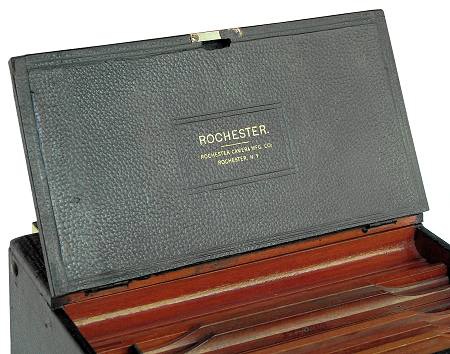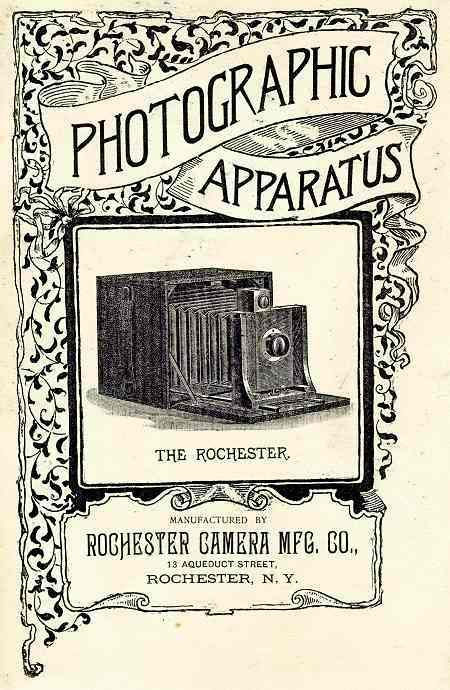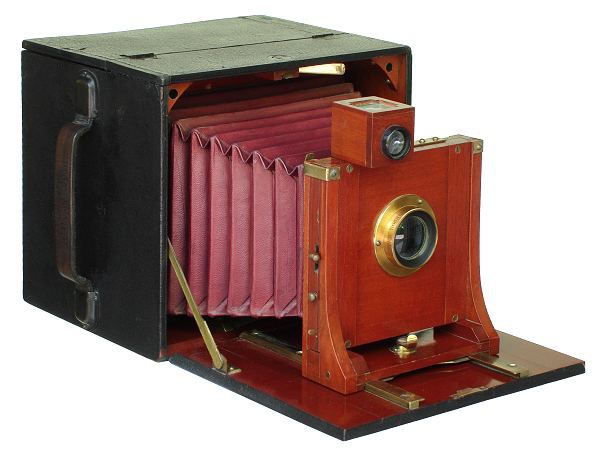|
|




1893 Rochester Camera, 5 x 7 inch format, R.C.M.Co. Rapid
Symmetrical Lens and Patent Automatic Setting Shutter.
The simplest and most convenient camera of this type yet
produced. The 1890s can be considered the decade of self-casing
cameras. It was a time when builders made great strives in
simplifying plate camera designs that would finally reach deeply
into an untapped amateur market.
While the earliest versions appeared in 1883 as the Pearsall Compact Camera and the Gibbs Camera of 1888, a true portable, leather covered self-casing camera waited until George Eastman introduced in 1890 the roll film only No.4 Folding Kodak.
Now that Eastman validated this new market, the next two years saw the American Optical Company and Blair Camera Company leaping into the frey with their own designs; the 1891 Henry Clay Camera and 1892 Blair Folding Hawk-Eye Cameras. The race was now underway.
While the earliest versions appeared in 1883 as the Pearsall Compact Camera and the Gibbs Camera of 1888, a true portable, leather covered self-casing camera waited until George Eastman introduced in 1890 the roll film only No.4 Folding Kodak.
Now that Eastman validated this new market, the next two years saw the American Optical Company and Blair Camera Company leaping into the frey with their own designs; the 1891 Henry Clay Camera and 1892 Blair Folding Hawk-Eye Cameras. The race was now underway.
Also recognizing the trend, two of the "Rochester" companies joined the club in 1892; the Rochester Camera Manufacturing Company with their own
version called The Rochester and the Rochester Optical Company with its Premier Folding Camera.
The Rochester, 1892-93(?)
Rochester Camera Manufacturing Co. Rochester, NY.
Rochester Camera Manufacturing Co. Rochester, NY.
Multi-Lens Cameras | View Cameras | Self-Casing Cameras | Solid Body Cameras | References & Advertisements
Home | What's New | Show Schedule | Wanted | For Sale | Links | Site Map | Email
Home | What's New | Show Schedule | Wanted | For Sale | Links | Site Map | Email
Copyright ©2008 by Rob Niederman - ALL RIGHTS RESERVED
Visit the Rochester Camera Reference page
Return to the Self-Casing Cameras page
Return to the Self-Casing Cameras page
On a historic note, The Rochester is often incorrectly referred to as "The
Folding Rochester." The actual name of this camera is "The Rochester"
followed by the format size and "Folding." In the 1893 catalogue, for
example, this camera is listed as "Rochester 5 x 7 Folding."
The Rochester is a beautifully constructed camera made of highly polished mahogany, lacquered brass, and fine grain leather. Unlike models made by Kodak, American Optical, and Blair, the Rochester has a simple easy to use appearance.
The Rochester's design borrows several different elements from its competitors; Kodak's top loading feature, the internal shutter from Blair's 5 x 7 Folding Hawkeye No.1, and top mounted viewfinder from American Optical's Henry Clay.
But compared to its competitors, the Rochester is smaller and lighter, yet does not have many of the advanced features that sophisticated photographers might find attractive.
The Rochester is a beautifully constructed camera made of highly polished mahogany, lacquered brass, and fine grain leather. Unlike models made by Kodak, American Optical, and Blair, the Rochester has a simple easy to use appearance.
The Rochester's design borrows several different elements from its competitors; Kodak's top loading feature, the internal shutter from Blair's 5 x 7 Folding Hawkeye No.1, and top mounted viewfinder from American Optical's Henry Clay.
But compared to its competitors, the Rochester is smaller and lighter, yet does not have many of the advanced features that sophisticated photographers might find attractive.
Looking from the rear, the open lid displays
the maker's identification in gold lettering.
The Rochester Mfg. Company must have felt that the camera was
important and decided to prominently illustrate it on the cover of their
1893 Photographic Apparatus catalogue.
Several sizes were offered including 4 x 5 ($30), 5 x 7 ($40), 6-1/2 x 8-1/2 ($60), as well as a 5 x 7 stereo model ($35 without a lens). Models with external shutters were also offered, but the internal shutter version appears to be the rarest of the series.
Several sizes were offered including 4 x 5 ($30), 5 x 7 ($40), 6-1/2 x 8-1/2 ($60), as well as a 5 x 7 stereo model ($35 without a lens). Models with external shutters were also offered, but the internal shutter version appears to be the rarest of the series.
